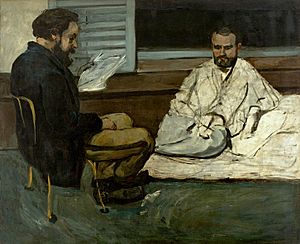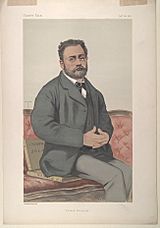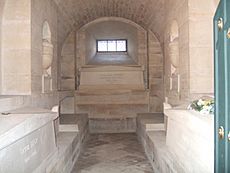Émile Zola facts for kids
Quick facts for kids
Émile Zola
|
|
|---|---|
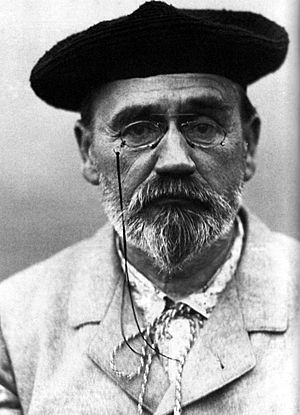
Zola in 1902
|
|
| Born | Émile Édouard Charles Antoine Zola 2 April 1840 Paris, France |
| Died | 29 September 1902 (aged 62) Paris, France |
| Resting place | Panthéon, Paris and Coupvray |
| Occupation | Novelist, journalist, playwright, poet |
| Nationality | French |
| Genres | |
| Literary movement | Naturalism |
| Notable works | Les Rougon-Macquart, Thérèse Raquin, Germinal, Nana |
| Spouse | Éléonore-Alexandrine Meley |
| Relatives | François Zola (father) Émilie Aubert (mother) |
| Signature | |
 |
|
Émile Zola (born April 2, 1840 – died September 29, 1902) was a famous French writer and journalist. He is best known for helping to create a writing style called naturalism. This style focused on showing life as it really was, often looking at how people's surroundings and family history shaped them. Zola also played a big part in making France more open and fair. He famously helped a falsely accused army officer named Alfred Dreyfus. Zola was even nominated for the first Nobel Prize in Literature twice.
Contents
Early Life and Beginnings
Émile Zola was born in Paris, France, in 1840. His father was an Italian engineer, and his mother was French. When Émile was three, his family moved to a town called Aix-en-Provence. Sadly, his father died four years later, leaving his mother with little money.
In 1858, Zola and his mother moved back to Paris. His childhood friend, the famous painter Paul Cézanne, soon joined him there. Zola first tried writing in a romantic style. His mother hoped he would become a lawyer, but he failed his exams twice.
Before becoming a successful writer, Zola worked low-paying jobs. He was a clerk at a shipping company and later worked in sales for a publisher. He also wrote reviews about books and art for newspapers. As a journalist, Zola was not afraid to share his opinions, even if they were against powerful leaders like Napoleon III.
Life as a Writer
In 1862, Zola became a French citizen. He married Éléonore-Alexandrine Meley in 1870. She was a great support to him throughout his life and helped promote his writing. Later in life, Zola had two children, Denise and Jacques.
In 1888, Zola got a camera and became very skilled at photography. He took many pictures, showing his interest in observing the world around him.
During his early years, Zola wrote many short stories, essays, and a few novels and plays. One of his first important books was Contes à Ninon, published in 1864. His novel Thérèse Raquin (1867) was a major step in his career. After this, Zola began his most famous work, the series called Les Rougon-Macquart.
Zola remained good friends with Paul Cézanne. Cézanne even painted a portrait of Zola with another friend, writer Paul Alexis.
The Rougon-Macquart Series
More than half of Zola's novels are part of the twenty-book Les Rougon-Macquart series. This huge project tells the story of one family during the time of Napoleon III's rule in France. Zola planned the entire series from the beginning.
The books explore how a family is affected by their environment and their family history. They show how violence and social problems became more common during the Industrial Revolution. The series follows two main branches of the family, the respectable Rougons and the less respected Macquarts, over five generations.
Zola wanted to show how people in a family, even if they seem different, are connected by their genes and their surroundings. He believed that these factors followed rules, much like gravity.
Zola and Cézanne had a disagreement later in life. This happened because Zola wrote about painters and their lives in his novel L'Œuvre (The Masterpiece), and Cézanne felt it was too much like his own life.
After 1877, with the success of his novel L'Assommoir, Émile Zola became very wealthy. He earned more money than even famous writers like Victor Hugo. His books Nana (1880) and La Débâcle (1892) sold even more copies. Zola became a leading figure in French literature. He often hosted dinners for other writers at his large home in Médan, near Paris.
Zola wrote every day for about 30 years. His motto was "not a day without a line." His works also inspired operas, like Louise by Gustave Charpentier. Zola's writing style, naturalism, was influenced by ideas about family traits and how surroundings affect people. He also drew inspiration from realistic writers like Balzac.
Zola is seen as a major influence on modern journalism, inspiring writers to document society in a detailed way.
The Dreyfus Affair
The Dreyfus affair was a huge scandal in France that divided the country. It involved Captain Alfred Dreyfus, a Jewish officer in the French army. In 1894, Dreyfus was wrongly accused of passing military secrets to Germany. Even though there was no real proof, he was found guilty of treason and sent to a prison island.
Later, another officer found evidence that someone else was the real spy. But instead of clearing Dreyfus, some high-ranking officials tried to cover up the mistake. They even forged documents to make Dreyfus look guilty.
Émile Zola believed Dreyfus was innocent and that a terrible injustice had happened. On January 13, 1898, Zola took a big risk and published a powerful open letter on the front page of a Paris newspaper called L'Aurore. The letter was titled J'Accuse…! (meaning "I Accuse…!").
In J'Accuse…!, Zola openly accused the French Army's leaders of covering up the truth and being unfair to Dreyfus. Zola hoped that by publishing this letter, he would be put on trial for libel (publishing false statements). This would force the new evidence supporting Dreyfus to be made public.

Zola was indeed put on trial in February 1898 and found guilty. He was removed from the Legion of Honour, a high French award. To avoid further legal trouble, Zola fled to England in July 1898. He lived there for about a year, visiting places like Westminster Abbey and staying in different towns.
Meanwhile, the truth about the Dreyfus affair slowly came out in France. The forgery was discovered, and Dreyfus's case was reviewed. In June 1899, the original guilty verdict was canceled, and a new military trial was ordered. Zola returned from England that same month.
Even after a new trial, Dreyfus was again found guilty, though with a shorter sentence. However, he was later offered a pardon, which he accepted to gain his freedom. Dreyfus was finally completely cleared of all charges in 1906, several years after Zola's death.
Zola's brave actions in the Dreyfus affair showed the power of writers and thinkers to influence public opinion and fight for justice. He famously said, "The truth is on the march, and nothing shall stop it."
Death
Émile Zola died on September 29, 1902. He passed away from carbon monoxide poisoning due to a problem with his chimney. His funeral was attended by thousands of people, including Alfred Dreyfus. Zola had just finished a novel about the Dreyfus trial before his death.
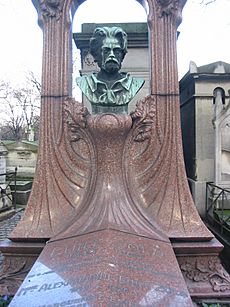
Zola was first buried in the Montmartre Cemetery in Paris. But in 1908, his remains were moved to the Panthéon, a special building in Paris where many important French figures are buried. He rests there alongside other great writers like Victor Hugo and Alexandre Dumas.
What is Naturalism?
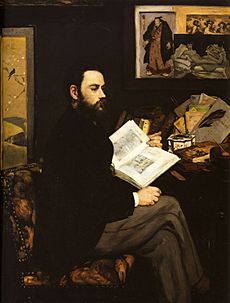
Zola was the leader of the "naturalist" movement in literature. He believed that novels should be like scientific experiments. Writers should observe the world carefully and document it in detail, just like scientists do. Zola thought that novels could explore human behavior and psychology, showing how people are affected by their environment and their family background.
To write his novels, Zola did a lot of research. For example, he visited a coal mine in northern France to prepare for his novel Germinal. He also traveled on railway lines for La Bête humaine. This careful research helped him create very realistic and detailed stories.
Zola wanted his characters to seem real, not bigger than life. While some critics felt his characters were not always memorable, Zola often created powerful symbols in his books. For instance, the mine in Germinal or the still in L'Assommoir feel almost like living beings, full of energy and life.
Images for kids
See also
 In Spanish: Émile Zola para niños
In Spanish: Émile Zola para niños



